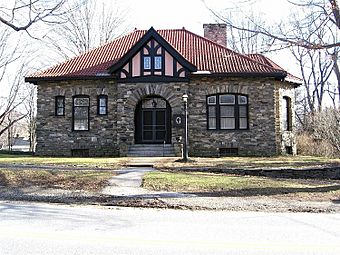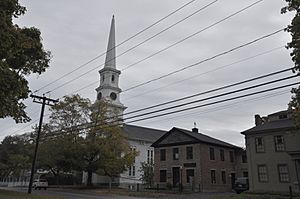Thompson Hill Historic District facts for kids
Quick facts for kids |
|
|
Thompson Hill Historic District
|
|

Ellen Larned Memorial Library
|
|
| Location | Chase & Quaddick Rds., CT 193 & CT 200, Thompson, Connecticut |
|---|---|
| Area | 550 acres (220 ha) |
| Architect | Shepley, Rutan and Coolidge; Et al. |
| Architectural style | Colonial Revival, Greek Revival, Federal |
| NRHP reference No. | 87002186 |
| Added to NRHP | December 31, 1987 |
The Thompson Hill Historic District is a special area in Thompson, Connecticut. It's like a time capsule showing how towns looked long ago. This district covers about 550 acres. Its main part is the Thompson Center Green, a park-like area. This green was first planned in 1735 when the town began.
Thompson Hill was once the main center for the town's activities and businesses. Later, other areas with factories became more important. But Thompson Hill still has many beautiful old buildings. These buildings were built in the 1700s and early 1800s. The district was added to the National Register of Historic Places in 1987. This means it's recognized as an important historical site.
Contents
Exploring Thompson Hill's Past
Thompson was first settled around the year 1700. At that time, it was part of a larger town called Killingly. Thompson became its own separate town in 1785. The area was also near a former Native American "praying town" called Quinnatisset. These were places where Native Americans lived and learned about Christianity.
Early Days and Growth
An early inn, or tavern, was built on Thompson Hill by 1716. It served people traveling on the main road to Providence, Rhode Island. In 1730, people living there asked to have their own church area. This request was approved. The first church building, called a "meeting house," was built in 1735 in this very spot.
In 1797, Thompson Hill became even more important. New toll roads, called turnpikes, were built and crossed here. These roads are now known as Routes 193 and 200. The new roads brought more people and businesses to the village. Thompson Hill grew and did very well until about 1850.
Changes and Revival
After 1850, trains became a popular way to travel. The railroad lines did not go through Thompson Hill. Instead, they went through other parts of town. This meant that the village became less important for business. The town's main focus moved to areas with mills and factories. This stopped a lot of new building in Thompson Hill.
However, Thompson Hill saw a small comeback in the early 1900s. Wealthy people started building large country homes nearby. They were attracted by the village's old-fashioned charm.
Historic Buildings and Landmarks
The Thompson Hill Historic District covers 550 acres. It includes more than 100 buildings that are important to history. Many of these buildings show styles like Colonial Revival, Greek Revival, and Federal architecture.
Some notable places in the district include:
- The Cottage House: This is a historic bed and breakfast.
- Thompson Congregational Church: A beautiful old church.
- The original Thompson Meeting Hall: Also known as "The Old Town Hall."
- The Ellen Larned Museum: A place to learn about local history.
The district also includes the former country estate of Norman B. Ream. This estate is now home to the Marianapolis Preparatory School. The beautiful gardens and grounds of the school were designed by the famous Olmsted Brothers firm. They were well-known for designing parks and landscapes.




